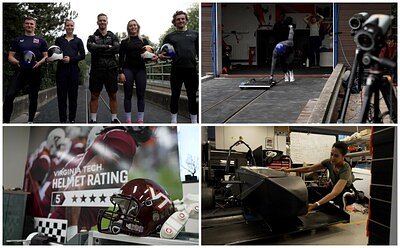
Beyond the Launch: Tech Transforming Sports Safety & Performance
From AI-powered motion capture to advanced helmet testing, innovators are pushing the boundaries of sports tech. We explore the science and impact behind these game-changing advancements.
Beyond the Launch: Tech Transforming Sports Safety & Performance
By Angela Gray
For decades, sports have been defined by physical prowess, strategic thinking, and relentless competition. But beneath the surface, a quiet revolution is underway – driven by cutting-edge technology that’s not just enhancing performance, but fundamentally altering how we approach safety and rehabilitation. CNN’s recent “Tech for Good” series highlighted some of these advancements, and a deeper look reveals a landscape brimming with innovation and potential. This article explores the science, the impact, and the future of sports technology, focusing on research from the University of Hong Kong (HKU), the Virginia Tech Helmet Lab, and the University of Bath.
Beyond Brute Force: The Rise of Data-Driven Performance
Traditionally, athlete training focused on repetition, endurance, and instinct. Today, data is king. At the forefront of this data revolution is the University of Bath's CAMERA (Centre for Analysis of Motion, Entertainment and Research Applications). Their unique approach involves markerless motion capture – a technology that moves beyond the cumbersome, lab-bound systems of the past. Instead of attaching sensors to athletes, CAMERA utilizes sophisticated camera systems and AI algorithms to track movement with remarkable accuracy, all without physical contact.
“The beauty of this system is its flexibility,” explains a researcher involved with the project. “We can analyze movements in real-world environments, like a training track, providing valuable insights that wouldn’t be possible in a controlled lab setting.”
This technology isn’t limited to elite athletes. Physiotherapists are increasingly utilizing markerless motion capture to assess patient recovery, design personalized rehabilitation programs, and objectively track progress. This is particularly impactful in diagnosing and treating musculoskeletal conditions, as well as neurological disorders where subtle movement patterns can reveal critical insights.
Protecting the Brain: The Virginia Tech Helmet Lab's Impact
While performance enhancement grabs headlines, athlete safety remains paramount. The Virginia Tech Helmet Lab, led by Professor Steve Rowson, has been a driving force in this arena for over a decade. Their independent helmet testing program, which goes beyond basic safety standards, has dramatically improved the safety of helmets across a range of sports.
Unlike traditional regulatory testing, the Virginia Tech lab employs a star-rating system (one to five stars) that publicly ranks helmets based on their ability to reduce concussion risk. This transparency empowers consumers – athletes, parents, and coaches – to make informed decisions when purchasing protective gear.
“The star rating is about providing actionable information,” says a researcher affiliated with the lab. “It’s not enough to just say a helmet meets minimum safety standards. We want to show consumers which helmets offer the best possible protection.”
The impact of the lab’s work has been significant. Manufacturers have responded to the ratings by investing in innovative materials and designs, resulting in a steady improvement in helmet safety across various sports. The star rating has become a key consideration for consumers, and major retailers have partnered with the lab to display ratings in stores and online.
Hong Kong’s High-Tech Race Car: A Testbed for Innovation
Across the globe in Hong Kong, the University of Hong Kong Racing (HKUR) team is pushing the boundaries of electric vehicle technology. The team, comprised of students from various disciplines, designs, builds, and tests electric formula-style race cars for the prestigious Formula Student competition. Their latest project involves developing a unique Electrical Control Unit (ECU) that optimizes both performance and safety.
“This project is about applying theoretical knowledge to real-world challenges,” explains a team member. “We’re not just building a fast car; we’re designing a system that prioritizes safety and reliability.”
The ECU incorporates advanced algorithms and sensors to monitor critical parameters such as battery temperature, motor performance, and braking force. It also includes safety features such as automatic emergency shutdown and regenerative braking. The project serves as a valuable training ground for future engineers, providing them with hands-on experience in designing and building complex systems.
Challenges and the Future of Sports Tech
Despite the remarkable progress in sports technology, several challenges remain. One major hurdle is the cost of these technologies, which can be prohibitive for smaller organizations and developing countries. Another challenge is the integration of data from multiple sources, requiring sophisticated data analytics and machine learning algorithms.
Looking ahead, several trends are poised to shape the future of sports tech. Artificial intelligence (AI) will play an increasingly important role in areas such as athlete monitoring, injury prevention, and performance optimization. Wearable sensors will become more sophisticated, providing real-time data on a wider range of physiological parameters. Virtual and augmented reality (VR/AR) will revolutionize training and fan engagement, providing immersive and interactive experiences.
“We’re only scratching the surface of what’s possible,” says a leading researcher in the field. “The combination of data, AI, and advanced materials will transform sports in ways we can only imagine.”
Ultimately, the goal of sports technology is not just to enhance performance, but to make sports safer, more accessible, and more enjoyable for everyone. By embracing innovation and addressing the challenges that lie ahead, we can unlock the full potential of sports tech and create a brighter future for athletes and fans alike.
📝 This article is still being updated
Are you a relevant expert who could contribute your opinion or insights to this article? We'd love to hear from you. We will give you full credit for your contribution.
Contribute Your Expertise →